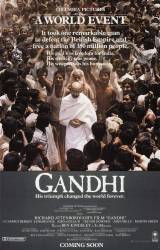Factual error: Jan Christiaan Smuts is referred to as the Prime Minister of the Union of South Africa in this film when Gandhi is there. Smuts didn't gain the office until 1919, after the death of Prime Minister Louis Botha. Gandhi left South Africa in 1914 and never returned.
Factual error: During the scenes of the Calcutta riots and various other places, we see various cars from the 50's when the events in question took place in the 40's. Most notably several Morris cars which hadn't been built yet.
Factual error: When Gandhi and Charlie Andrews are accosted in the street by a group of thugs, and the two of them are eventually allowed to pass, there is a major factual error. Gandhi was in fact kicked off the pavement in front of what was once President Paul Kruger's house in Church Street, Pretoria. The house (now a museum) is not in the centre of town but is on the corner of Potgieter and Church Streets, some way from the exact CBD. Richard Attenborough shows us that the place where this happened is in what is supposedly Pretoria's town centre. I know this because I live in Pretoria.
Factual error: When the flag raising ceremony is shown after the creation of Pakistan in 1947, the Pakistani national anthem is played, which was only composed in 1949.






Answer: Brigadier-General Reginald Dyer has said his intent "was not to disperse the meeting but to punish the Indians for disobedience." Earlier that day, Dyer has banned all meetings to avoid any insurrection, but many still gathered to celebrate and protest. Dyer saw it as defiance of his order and thought it could be another mob insurgent he had seen earlier. Some reports also state while the crowd was "unarmed", that only referred to being unarmed with firearms and many in the crowd did have other types of weapons. It also seems at the time it was standard practice for the British Army to use necessary lethal force for civilian crowd control, although many saw Dyer's action to be in excess.
Bishop73